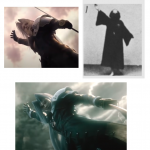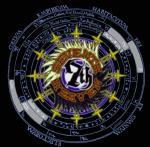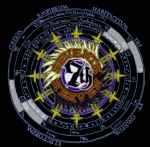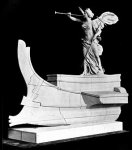ProfessorGast
Lv. 25 Adventurer
- AKA
- JustinC721
FYI: This post is going to be work in progress as it is going to cover alot of subject matter. Especially in regard to the number 49. In my effort to keep things concise, I will have some blank replies that I intend to use as place holders to separate certain topics/entries as needed.
Introduction:
This post is in reference to a book titled "Sepher Sephiroth" which is a book of numerological references written by Aleister Crowley. The references contained within this book pertain to Hermetic philosophies which has it's origins in the Greek Hellenistic period and is thus, mostly a combination of Hebrew, Egyptian and Greek mythologies. Mostly the latter in that regard. But first, I need to explain a little bit of history and go over some concepts before we proceed in to the numerology.
This is due to the more commonly accepted association with with Sephiroth and the Hebrew Kabalah which has very little to do with Sephiroth beyond it's basic definitions. On that topic, I know this statement will ruffle a few feathers, but if you happen to be someone who struggled to find the connection between FFVIIs Sephiroth and The Sefirot, of the Hebrew Kabbalah. then you are about to find your answers.
My Research:
Fist and foremost, I am not a scholar. Even though I try to be as 'academic' as possible and learn from legitimate sources, I am still a layman. Some of these subjects get rather deep and the nature of religion and philosophy, does require one to draw their own personal conclusions from it even if you don't practice the religion yourself. I personally identify as an agnostic. In that regard, I am skeptical of some of these teachings to a degree such as numerology and astrology, but I know there are people who do. My intention here is not to disrespect anyone's personal beliefs, nor push any of these beliefs on to others.
In that regard, I am referring to The Sephiroth of the Hermetic Qabalah which involves many esoteric concepts and the like which are not as simple as 'good' vs 'evil'. That said, I will go over what is necessary, but before that I would like to start with a little bit of history starting with Mr Crowley. Yes, that Mr Crowley.
Mr Aleister Crowley:
That said, there happens to be alot of fiction based in his work. Much of which goes uncredited due to him being a controversial figure. I also want to point out that FFVIIs early script did involve many of these concepts. Why they were removed is unclear, however given the timeframe (1997), the video game industry was under heavy scrutiny for getting 'too edgy'. There is also the long and well documented history of religious references and symbols being scrubbed in western releases. One example in Crisis Core would be the statue in the Banora Underground.
I also want to point out that I cannot be entirely certain if FFVII got the idea for Sephiroth from Aleister Crowley as his Thelema Religion and general Hermetic Teachings are very similar. However, Crowley is the person most directly responsible for it's occult influence in the modern day. He also wrote a book titled "Moonchild" which is a story about a mage war in which a black magician attempts to impregnate a woman with an ethereal being in a series of 'magickal expiriments' in an effort to produce a 'moonchild' which is basically a half human / half cosmic entity. Now if that doesn't sound familiar enough. I should also point out that Sephiroth's 'Other Mother's' name is "Lucrecia Crescent". Make of that what you will.

The black robed figure in the upper right is Crowley in "Tau Robe" which have become stereotyped with the occult and are the same type of robe worn by the Sephiroth Clones. Crolwley (robed figure) is shown in a ritual stance called "earth, God, set fighting". This happens to be one of Sephiroth's favorte battle stances which is self explanatory.
Hermetic Philosophy and the Greek Hellenistic Period:
Hermetic philosophy influenced much of early Christianity, Judaism, and even Islam to a degree. This lasted until the British Empire began cracking down on 'sorcery' at which point, those who practiced Hermeticism were deemed 'heretics' which resulted in Hermetecism evolving into occult in the west. In that regard, Hermetic influence on Christianity still exists in the Eastern Orthodox variety as Orthodox Christianity evolved from the East Roman (Byzantine) Empire and thus carried it's Greek influence as the East Roman Empire primarily spoke Greek whereas the West Roman Empire spoke Latin.
Something interesting in regard to the Hellenistic Period is this statue which seems like a very likley candidate for source of inspiration behind the Jenova Effigy which is something I found by pure happenstance )like many other things) while researching Sepher Sephiroth. The pictures of the statue's restoration is where it gets interesting along with how it is believed to have been displayed in ancient times. Link - IRL Jenova Effigy

Hence, my namesake because it's not everyday that you find Jenova.
Hermetic Philosophy and the Victorian Era:
Hermetic philosophy saw a revival during the Victorian era as occults such as the "Hermetic Order of the Golden Dawn", "Chaos Magick", and "Thelema" formed as a counter culture. All three of these are associated with Aleister Crowley as he founded the latter, "Thelema" which is the Greek word for "will' which is in reference to 'spiritual will'. These latter variations on Hermeticism incorporated elements from even more religious practices. Most notably Thelema which has elements from 9ijmBuddhism, Islam, Hindu and even Aztec beliefs resulting from Crowley's travels.
The Hermetic Qabalah and the Sephiroth vs. The Hebrew Kabalah and the Sefirot.
There are numerous variations on the Qabalah along with variations on it's spelling. These are similar in the basic sense, but are also very different and the spelling differences are used to express those differences. The Hebrew Kaballah is the most common variation people are familair with and is hence believed to be the origins of Sephiroth and Jenova. I do not agree with those sentiments as the similarities end once you've look past the basic definition of those terms which are common to all variants of the concept which I will go over next.
Definitions - Kabbalah/Qabalah & Sefirot/Sephiroth:
The words are Hebrew in origin as they mean "Tradition" "Correspondence" and "Reception". Therefore it could be referred to as 'communication or communion through ceremony'. Like becoming one with a greater power. Such as Jenova and reunion, or Aerith becoming one with the planet. The word "Sephiroth" comes from the term "Sephirah" which means 'expression' or 'emanation'. Therefore, the Sephiroth is the expression of divine will. While Aerith can summon holy, it is up to the planet whether it decides to stop Meteor. Therefore, Aerith became an expression of the planets will to stop Meteor. Thus, making Aerith a Sephiroth of the planet.
Alternatively, Watashi Sephiroth becomes one with Jenova after his death and thus becomes and expression of its will. Making him a "Sephiroth" of Jenova. Hence, his namesake.
This is where the similarities mostly end with the exception of 'Moses' and being the most commonly citied example of the sefirot in Hebrew Mythology. Some of which happened to be contained within "Sepher Sephiroth". That said, some mythology that is attributed to Moses is also part of other mythologies too. Such as Caduceus, Rod of Aaron, and the Bronzed Serpent.

Did....... Sephiroth do this?
While the Hermetic Qabalah has some things in common with the Hebrew Kabalah, there are many differences once you get into the Hermetic aspects of it. One key difference is that the Hermetic Qabalah is based in the Kybalion rather than Hebrew Mythology. This is important because the Kybalion is not monotheistic as its subject matter pertains to Ancient Greek and Egyptian Mythology and the teachings of Hermes Trismegistus.
Despite being non monotheistic, does not mean they don't have a supreme god. However, they do not hold the belief that 'god is perfect', nor do they hold the belief that god is eternal.... sort of. The latter is a complicated subject which relates to the concept of 'pantheism' which is also part of their teachings. These aspects get into some deep subject material which I'll go over when necessary. To oversimply, just think of eternity as something that defines one's conscious existence. Many of these concepts deal with philosophies that involve observation, perception and thus, personal truths in relation to the greater universe.
The Concept of Good vs Evil
This subject would be more accurately defined as Thesis vs Antithesis, but I don't wanna sound to pretentious. That said, the concepts of good and evil are rarely (if ever) cut and dry. As I was saying earlier, many concepts in these teachings involve matters of perception. Like one man's misery is another man's fortune. There are alot of 'yin/yang' concepts at play and there is no such thing as pure good and evil as the central tenet to this philosophy is that one must follow their 'true will'. Hence, the name "Thelema" (Greek for 'will') and their mantra "Do what thou wilt shall be the whole of the law" which means that one should seek their true path, or 'destiny' if you will.
Divinity - The Sepiroth and the Qabalistic Tree of Life:
The concept of divinity is associated with that of "The Great Work". Which is an expression of one's true will in the form of their achievements or their greatest achievement towards their goal regardless of whether it something that is 'good' or bad. President Shinra is a prime example of this in his dialogue with Barret at the end of Chapter 17. He knows what he wants and he takes it. He follows his path and place in the FFVII universe and facilitates the chain of events to carry out as they should. President Shinra's Great Work would be Midgar, the City of Mako as a monument of his greed and hubris.
Corruption - The Qliphoth and the Qabalistic Tree of Death:
As previously stated, divinity is following one's true will. Therefore, the antithesis is defiance of true will. Or defiance of 'destiny'. This basically teaches that defying ones true will. Not following one's true will creates a disruption in the greater order of things. Thus will result in negative consequences which the universe will express to you various forms of 'bad luck' or 'tragedy', etc. The 'qliphoth' is the embodiment of this which is the antithesis to the Sephiroth. The latter means 'expression' whereas the former means 'empty' for or lack of expression. More specifically, the word "qelippot" which means 'peels', 'husks', or 'shells'. Basically what is left after something has been consumed. Like something that's...... Hollow inside.
If you hadn't guessed by now. The Qliphoth will be a very important topic going forward.

This is the Hermetic illustration of the Qabalistic Tree of Life and Death with the latter being associated with the Qliphoth (left). The Qliphoth is illustrated with 10 black feathers arranged in a radial patter. Sephiroth's god form is that of a Seraph which is the 5th order of angel of the Qabalah, and has 5 black feathers arranged in a radial pattern around his belt buckle. That said, I have many doubts regarding Remake Sephiroth's identity which I'll get into later. I will be interested to see of this belt buckle makes an appearance in Crisis Core Reunion.
Another thing I'll point out about Seraph angels is they have an alternate form which is that of a serpent. How's that for an 'eye opener'?
Defiance of True Will:
As stated earlier regardig the Sephiroth and the Qliphoth, These concepts are deeply intertwined, yet contradictory in certain context. Because what if you are in disagreement with 'destiny' and that is not you 'true will'? There is a way according to their philosophy which I'll get into when and if the time comes. To sum things up simply, it takes a very strong willed individual or collective to make something like that happen without negative consequences.
How Destiny is Determined:
Destint is defined by a concept known as the "Sphere of the Fixed Stars" which abbreviated as "S.F.F." in Sepher Sephiroth. This is in reference to the 12 Zodiac also known the "12 Houses of Heaven" as depicted in the Greek model of the solar system. Which is what Safer Sephiroth greets you with when he casts Supernova.

A simple copy/paste operation and the spokes where the black and white meet align with Aries (top right) and Libra (lower left). Libra is the 7th house and Aries is the first. The seventh heaven sign depeicts an 'equinox' which carries alot of meanings many of which are polarized. Hence, the 'yin yang' like appearance.
The term "native" is reffering to the native chart which is a person's 'natal chart' according to their time and place of birth. The end of his book shows numerous examples of these drawn for famous people of the day. And is belived to be what defines their destinty.The seventh house describes die partners of the native, primarily in marriage, but also in business and in other affairs of life which demand the co-operation of another person. It also deals with litigation, and describes any person openly opposed to the native.

Now you know what what those zig zaggy patters are on the FFVIIR loading screens. That's destiny my friend!

One final thing I should point out is that "Safer Sephiroth" is believed to be a mistranslation and that it is intended to mean 'Sefer' or 'Sepher". This book mostly consists of charts, mathematic formulas and tables as pythagorean numerology and 'magic squares' are involved. That said, Safer Sephiroth is quite the math whiz when he casts Supernova.
Attachments
Last edited:


